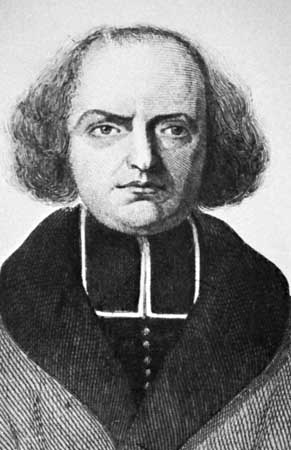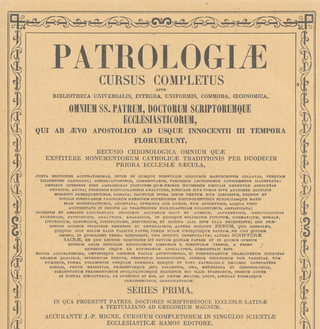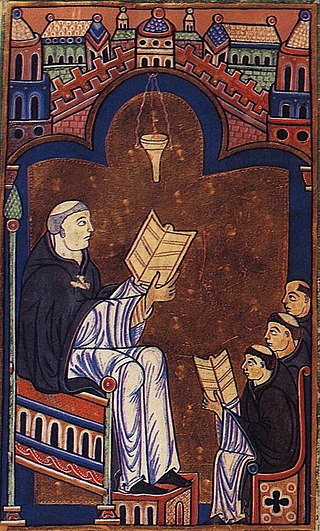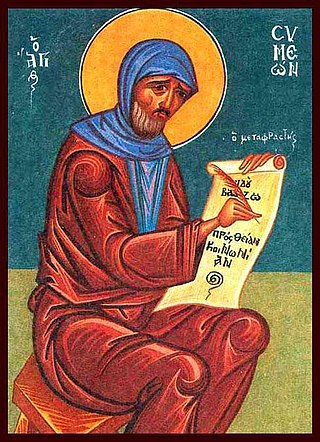Related Research Articles
Bartholomaeus Anglicus, also known as Bartholomew the Englishman and Berthelet, was an early 13th-century Scholastic of Paris, a member of the Franciscan order. He was the author of the compendium De proprietatibus rerum, dated c.1240, an early forerunner of the encyclopedia and a widely cited book in the Middle Ages. Bartholomew also held senior positions within the church and was appointed Bishop of Łuków in what is now Poland, although he was not consecrated to that position.

Nikephoros Kallistos Xanthopoulos was a Greek ecclesiastical historian and litterateur of the late Byzantine Empire. His most popular work, the voluminous Ecclesiastica historia, constitutes a significant documentary source on primitive Christianity and its doctrinal controversies, as well as for hagiographical, liturgical, and legendary texts from Byzantine culture.

Jacques Paul Migne was a French priest who published inexpensive and widely distributed editions of theological works, encyclopedias, and the texts of the Church Fathers, with the goal of providing a universal library for the Catholic priesthood.

George Pachymeres was a Byzantine Greek historian, philosopher, music theorist and miscellaneous writer.

Leo Allatius was a Greek scholar, theologian, and keeper of the Vatican library.
John Malalas was an East Roman chronicler from Antioch.

Eustathius of Antioch, sometimes surnamed the Great, was a Christian bishop and archbishop of Antioch in the 4th century. His feast day in the Eastern Orthodox Church is February 21.

The Patrologia Latina is an enormous collection of the writings of the Church Fathers and other ecclesiastical writers published by Jacques-Paul Migne between 1841 and 1855, with indices published between 1862 and 1865. It is also known as the Latin series as it formed one half of Migne's Patrologiae Cursus Completus, the other part being the Patrologia Graeca of patristic and medieval Greek works with their medieval Latin translations.

Hugh of Saint Victor was a Saxon canon regular and a leading theologian and writer on mystical theology.

Symeon or Simeon, distinguished as Symeon Metaphrastes (Latin) or Symeon the Metaphrast, was a Byzantine writer and official regarded as a saint in the Eastern Orthodox Church. His feast day is celebrated on 9 or 28 November. He is best known for his 10-volume Greek menologion, a collection of saints' lives.
The Patrologia Graeca is an edited collection of writings by the Church Fathers and various secular writers, in the Greek language. It consists of 161 volumes produced in 1857–1866 by J.P. Migne's Imprimerie Catholique, Paris.
George Kodinos, also Pseudo-Kodinos or Codinus, is the conventional name of an anonymous late 15th-century author of late Byzantine literature.

Arethas of Caesarea was Archbishop of Caesarea Mazaca in Cappadocia early in the 10th century, and is considered one of the most scholarly theologians of the Greek Orthodox Church. The codices produced by him, containing his commentaries are credited with preserving many ancient texts, including those of Plato and Marcus Aurelius' "Meditations".
George of Pisidia was a Byzantine poet, born in Pisidia. As an important early poet of Byzantine literature, his work "contributed a great deal to the formation of many of the main features of Byzantine poetry".
Hesychius of Jerusalem, also spelt Hesychios and also known as Hesychius the Priest, was a Christian priest and exegete, active during the first half of the fifth century. Nothing certain is known as to the dates of his birth and death (450s?), or, indeed concerning the events of his life. Bearing as he does the title πρεσβύτερος "priest", he is not to be confused with Bishop Hesychius of Jerusalem, a contemporary of Gregory the Great.

Eustathius of Thessalonica was a Byzantine Greek scholar and Archbishop of Thessalonica and is a saint in the Eastern Orthodox Church. He is most noted for his stand against the sack of Thessalonica by the Normans in 1185, contemporary account of the event, for his orations and for his commentaries on Homer, which incorporate many remarks by much earlier researchers.
Eutychius of Alexandria was the Melkite Patriarch of Alexandria. He is known for being one of the first Christian Egyptian writers to use the Arabic language. His writings include the chronicle Nazm al-Jawhar, also known by its Latin title Eutychii Annales.
Oecumenius is the name under which are transmitted several commentaries in Greek on the New Testament. It now appears that these were not all written by the same person nor in the same period.
George Metochites was an archdeacon in Constantinople during the 1270s and early 1280s, and an important, fervent supporter of the Union of the Greek and Latin Churches that was agreed to at the Second Council of Lyons (1274).

Severian, Bishop of Gabala in Syria, was a popular preacher in Constantinople from around 400 until 404. He became the enemy of John Chrysostom and helped condemn him at the Synod of the Oak.
References
- ↑ Latino Latini, Epistolae..., vol. 2, p. 116.